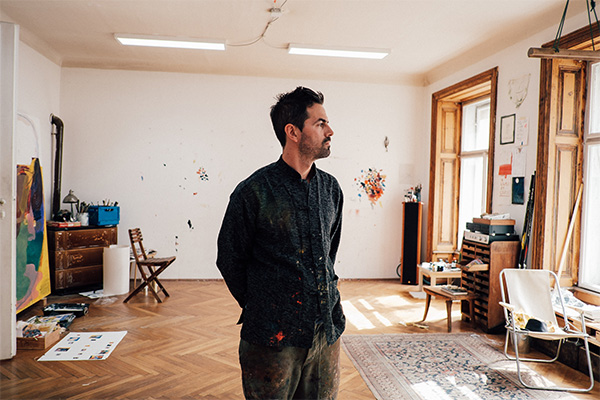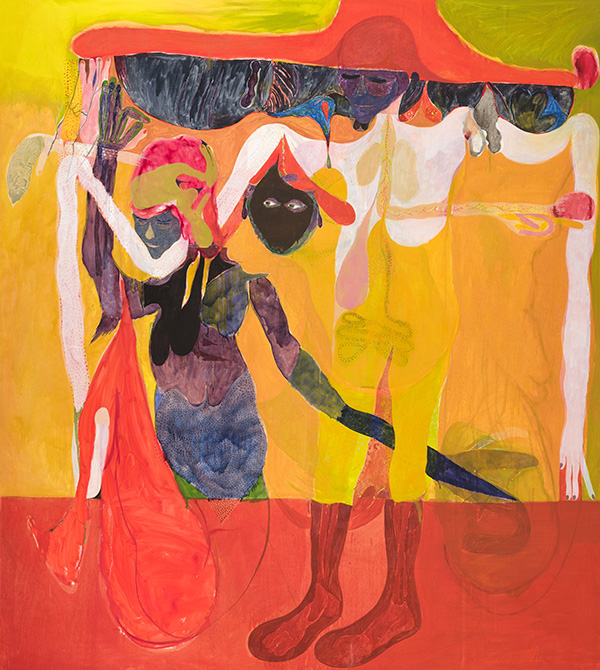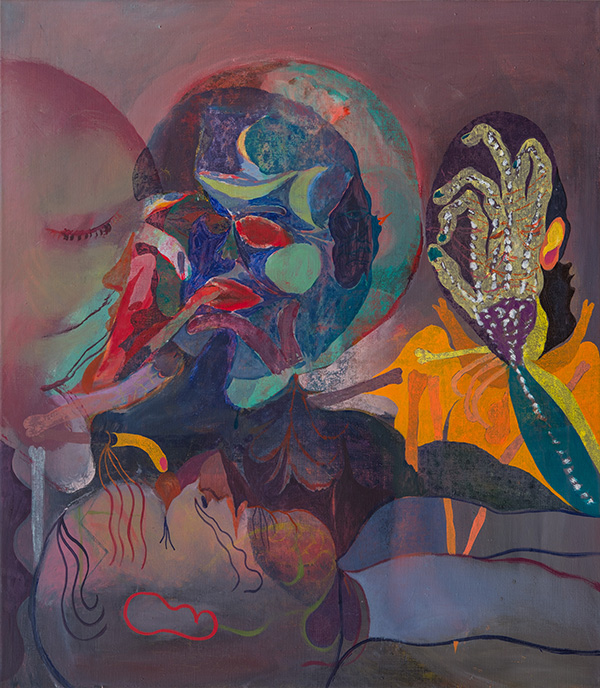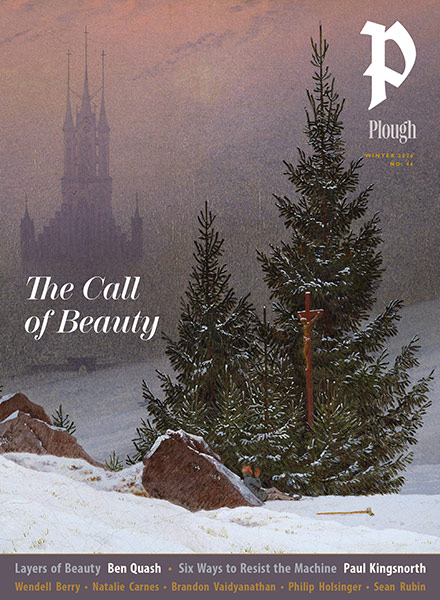Subtotal: $
Checkout
Artist Not for Hire
A contemporary painter describes how he balances his artistry with earning a living and parenting.
By Daniel Domig
August 12, 2025
Available languages: Deutsch
Known for artwork focusing on interpersonal relationships and the human body, painter Daniel Domig has received multiple awards. His works can be found in Essl, Leopold, Galerie Taxis Palais, and AMC Collezione Coppola. Born in Canada, Domig is the son of an American family therapist and an Austrian mountain farmer. He now lives with his wife and their four children in Vienna. He spoke with Plough editor Katharina Thonhauser about art, work, and how they relate to each other.
Plough: Did you want to be a painter as a child, just like other children want to be firefighters or police officers?
Daniel Domig: I knew even as a child: This is who I am. I didn't say I wanted to be a painter. I was given paints and brushes by a young student for my ninth birthday. He lived with us for a few months and was the first adult I met who painted. I had only known children who did that. At the time, I didn’t know any adults who did anything artistic full-time or even in their free time.
Something just clicked for me, and from that day on, I just knew that’s what I wanted to do. Even as a teenager, I worked my way through art history by painting. I copied paintings I found in books, and quickly set up a studio in the basement where I could work.
So, for me, being a painter wasn’t an end goal, but I told myself that I had already become one. This naivety and idealism led me to simply go through with it. For visual artists, especially now, there are very few points of reference to confirm whether you are on the right track or not. The audience decides, so to speak, whether something is good or not.
Can you make a living from your work?
It’s possible to make a living from it. Of course, as every self-employed person knows, it takes a bit of life skill. A visual artist only earns money by selling his work. When I do international exhibitions, the galleries cover the fixed costs, but I only earn an income when a piece is actually sold. This distinguishes visual artists from musicians who go on tour and receive a certain fee per concert.
I invest a lot in the unknown, a lot of time and organization for exhibitions, and of course a lot of money in materials that enable my art to be created in the first place. And then I have to hope that somewhere, people will be moved enough by my work that they want to support it. So far, I have been successful, but for many artists that hasn’t been the case.

Daniel Domig in his studio. Used by permission.
How do you deal with this uncertainty?
My wife and I are both self-employed. She is a marriage and family therapist, which is more predictable, but she can’t always guarantee that the phones will ring again next year. There’s usually a moment each year when we have a certain amount of expenses, for example, for the studio or materials, and we are not generating any income. But I don’t do commissioned work. What I do is really very pure work, free from “I do this because I get paid for it.” Of course, this purity also presents a challenge: How do you justify all those hours sitting and standing there doing something that no one asked for, and no one said they would buy? This results in a very special relationship with artistic work, because there is no impetus for it except the dialogue with the material itself and, of course, the resonance you get from it.
Is making art even work?
It depends what you mean by work. I think it’s a concept like love and God, which we inevitably fill with our experiences. I think for some people, the term “work” does not have positive connotations: “It’s just something that has to be done so I can buy and do the things I want.” Or “I have to go to work Monday through Friday so I can have my own life on the weekend.” Growing up, I was lucky that my parents were self-employed, not artistically, but in marriage and family counseling. My father also did a lot of crafting and repairing and had a workshop on the side. He was my role model, a person who did every activity with love and dedication. From him I learned that work is good in itself because it is dedicated to the material, and attempts to lovingly shape this raw material to create something more original and more meaningful than it was before.
What artistic value does your work have?
As a Christian, I see my relationship to work as a response to the reality that I am a creature in a created world and that I am, so to speak, a co-creator in a process of healing, of making whole, of changing, and of transforming toward more positive forms of the respective object. The difficulty of conceptualizing this in today’s society comes from the fact that we are used to asking: What’s in it for me? Behind this question is usually a strongly commercial-capitalist orientation: Can I buy something with it? For us, money has become the ultimate weapon against the difficulties of life.
It is exciting to see how art engages in dialogue with this question of functionality. In the best-case scenario, art always pierces through the veil society has drawn over it and demonstrates that everything has its place and fits in to the greater picture. Making these fractures visible is the first step toward genuine and not superficial healing. That is where art and my work function well, not when it is accepted into the system as a product worth thousands of euros, but where it creates something unsettling, where art manages to provoke us, especially in matters that our society would prefer to simply cover up or ignore.
How would you describe your paintings?

Daniel Domig, Cloak, oil on canvas, 2024. Used by permission.
They are process-oriented paintings. That means that there is no pre-existing image or concept in the paintings that is then implemented. This surprises many people, because generally, people assume that a visual artist has a statement or an idea and then uses their medium to express it. For me, the painting process has a built-in reflective moment: it’s a kind of trust that the work will enter into dialogue with others around me, with society, because they are looking at something that was made by a fellow human being. So it’s a form of communication, a sharing of this experience that I have as a human being.
Thematically, my art centers on relationships and mostly interpersonal ones. Like human relationships, my art displays figures that are still growing themselves, that look as if something is still missing, or as if something is still to come. So they sometimes give the impression that the works are not even finished, which is, of course, technically correct, because every completion of a painting is only an individual decision by the painter to stop painting.
Another painter might have finished earlier or later, and every completion is only provisional – as long as you don’t resume painting. When I leave the studio, the works remain where I stopped painting. When I come back the next day, there is a mutual questioning.
The painting asks me, and I ask the painting if it wants to continue. In this process, I see a very beautiful reflection of my Christian beliefs, how we are invited to view our fellow human beings, and also ourselves, not as finished beings but beings capable of transformation. The good news of the gospel is indeed the invitation to a radical change.
Saul becomes Paul, but even Paul is still a piece of the transformation process. Each of us who has experienced some form of positive change knows that we are still human beings and that crises will continue to arise in different areas of our lives. Must we question God’s faithfulness if our lives are not perfect? These are themes that appear repeatedly in my artwork. It is a rejection of staticity in our humanity and our relationships, and hope in this dynamism and constant transformation.
Is it difficult to part with a picture when you sell it?
It’s not difficult. I tend to only give the pictures to exhibitions when I have finished working on them, when I can no longer add more. And that is, of course, the hope in the maturing process of painting, that you develop an increasingly refined sense of how little the work actually needs from you.

Daniel Domig, Therapeutics, oil on canvas, 2023. Used by permission.
What does a typical workday look like for you?
I have four children. That means I get up very early. I also have a studio, a fixed workplace. The most difficult hurdle is getting everything else done so that I can spend as much time as possible in the studio on a regular basis. Every day is structured a little differently, but first and foremost, it’s a matter of clearing out the things that need to be done: writing emails, packing, driving to the hardware store. The actual artistic work begins when there is nothing left to do.
One might wonder: Doesn’t painting also belong on the to-do list? But I have to do the practical and logistical aspects of the work so that I am free from all other distractions, where I can simply let things happen.
From this cultivation of time, separating myself from other tasks, the artistic work grows on its own. This is a reflection of the gardener, who can only create conditions for growth; he cannot make anything grow himself. He can keep the soil fertile and make sure there is enough moisture and not too many stones. And then he can only wait. The sun does all the work with the seeds he planted. As an artist, I sometimes feel similar to a gardener, who rarely gets praise for the fertile soil he has prepared, but only for the roses that have grown in the garden. This makes me feel like I’ve produced nothing. I simply followed the call to repeatedly put myself in a state of conception where I was free from other activities, to become still to listen and watch for what wants to emerge. This is, of course, a special aspect of artistic work, because it is almost no work at all. It is more of a relationship with a remarkable reality.
What is the value of your art for society?
It is an invitation for people to put themselves in the same position of conception. A similar question could be asked about prayer. In the past, for example, there were professional prayer leaders. One might wonder if there was a point of that. Do we give God any information through prayer that he does not already have? One reason for prayer is that it allows us to celebrate a very special relationship with a living God who is always present and with whom we are constantly communicating and exchanging. But we celebrate it in a very special way in prayer when we pause, become calm, fold our hands, and sometimes close our eyes, or sometimes leave them open.
Paul Klee once said, “I believe that art is not about depicting something you see but about seeing in the first place.” The encounter with painting does not end when you leave the museum but actually begins when you leave the museum and suddenly see the reflection in a window differently. The red hue in the sky is now really noticeable for the first time. Or you come out of the concert hall, and the red hue in the sky really stands out for the first time. Suddenly, you hear how many birds are actually chirping. Something has taken root, or a seed has been planted by art, which will grow in every area of your life.

Daniel Domig, Tired of One’s Toil, oil on linen, 2016. Used by permission.
Who decides how much money a picture is worth?
It works like any other marketplace. I think since Bitcoin we have had confirmation that people are willing to assign value to completely fictitious things as long as there is the possibility of enriching themselves.
It makes me incredibly sad that art has also become a huge market, where often absurd sums are involved, and, I believe, a lot of money is also laundered. I would like to see an art and culture scene where artists are supported differently, so that they are not forced to be part of the market. The experience of art cannot be bought. Owning a work of art does not guarantee any experience.
But of course, there is an art market. And in a way, I am involved in it because I work with galleries that also buy art. I have been able to form friendships with people who bought my work without knowing me and then connected with me. That was a very healing experience. Despite this corrupt and crazy art market, in the end, both sellers and buyers are always human beings. And human beings, in my experience, are always looking to deepen their relationships, to form friendships, and to have genuine exchanges with others.
How do your children view your work?
Because they don’t know any different, they are disinterested in a healthy way. At first, I had a bit of a hard time with that. I thought, shouldn’t it be different? Shouldn’t my children spend more time in the studio and paint a little, and be a little creative, like in a Waldorf school? Then I realized that it’s the same for many others, that parents try to do their work as well as possible so that they can come home and fulfill their role as parents.
Is work-life balance difficult for you as an artist?
Yes, I’m often afraid that in the end, I’ll have to say I wasn’t really good at painting or being a dad because I tried to do both. I hope my kids will forgive me and appreciate the balance I tried to maintain. I’m ready to have a lot of conversations where I’ll have to ask for forgiveness At the same time, I have also managed to process this tension and this uncertainty and this despair that I feel when I am torn between two things in my work. It is no coincidence that, since we have had children, more and more heads and arms and feet have appeared in my work!
I believe that people who feel torn between different things themselves – who, with children, spouses, jobs, sick parents, and relatives scattered around the world, feel that their bodies are spread out and fragmented – can feel understood through my works. The figures in them are all stretched out or knotted together. And despite this chaos in the paintings, there is incredible beauty woven into these entanglements, so that you can acknowledge the unpleasantness but realize that the alternatives would only be worse.
Already a subscriber? Sign in
Try 3 months of unlimited access. Start your FREE TRIAL today. Cancel anytime.






